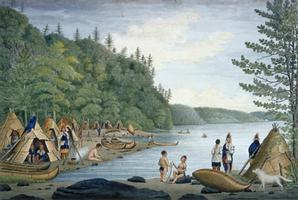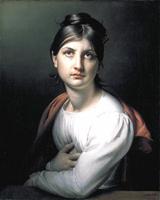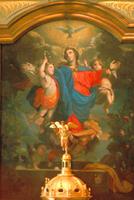Painting: Beginnings
The first references to Canadian subjects appeared in the decorated margins and vignettes of maps ("Mappemonde" by Pierre Desceliers) and atlases (Vallard's "Atlas," Guillaume Le Testu's "Atlas") in the mid-16th century. Made in Europe by artists who had never seen Canada but who based their pictorial work on travellers' accounts, these illustrations of the fauna, flora and human population of the newly discovered lands reflected their creators' prejudices as much as they did facts; in 1550 Desceliers placed pygmies near Hochelaga! Indian canoes, however, were frequently portrayed accurately.
Later travel chronicles continued the same ambivalence. The map of Hochelaga in Delle navigationi et viaggi (1550-59) of Giovanni Battista Ramusio looked more like a utopian Renaissance city than an Iroquois village, whereas the illustrations in Champlain's accounts were reasonably accurate, such as a Huron woman grinding corn in a mortar, or a Huron hunting scene.
The most remarkable document of this type is the Histoire naturelle des Indes occidentales (c 1685) by the Jesuit Louis Nicolas. His manuscript was illustrated by pen-and-ink drawings (the Codex canadensis) of the vegetation, animals and people of the New World. Certainly his versions of the fauna were inspired by the engravings in the Historia animalium of the great Swiss biologist Konrad Gesner, and his portraits of Indians by some poor illustrations in Historia Canadensis, seu Novae Franciae ... by Francois du Creux. But the abundance of detail, the representation of the flora, and the naive nature of the drawings combined to make this an important work.
The engravings in Moeurs des sauvages amériquains comparées aux moeurs des premiers temps (1724) by Joseph-François LAFITAU, although they drew heavily on the works of Théodore de Bry, also showed the extensive ethnographic knowledge of this Jesuit. The Histoire ... de la Nouvelle-France ... (1744) by Pierre-François-Xavier de CHARLEVOIX included several plates devoted to flora.
While these first images of Canada were appearing in Europe, the 17th-century French colonists in New France were importing paintings and engravings from France. Catholic missionaries used engravings and paintings to convert Indians and remind the settlers of their faith, as is suggested in the large painting La France apportant la foi aux Indiens de la Nouvelle-France (post-1666, Ursuline Convent, Québec), in which France is personified by Anne of Austria, teaching an Indian kneeling before her. We know that some priests (Jean Pierron and Claude CHAUCHETIÈRE) were painters themselves, but their work has been lost, except possibly for the portrait of Kateri TEKAKWITHA (c 1681) attributed to the latter.
For the late 17th-century Jesuits, the engraving by Grégoire Huret of 1664, the Martyre des pères jésuites ... was important enough to have a copy painted in France. Painted or engraved portraits of the Sun King (Louis XIV) made in the mother country were seen in New France; one such portrait certainly existed in the Château St-Louis, the governor's residence in Québec. Even Frère LUC, who spent 16 months in New France, must be considered an uncommitted transient, even though he left behind a fair-sized body of church paintings (L'Assomption, 1671, for the Hôpital-Général, Québec) and a Portrait de Monseigneur ... Laval (1671-72). It is less certain whether paintings hung in the more modest homes; however, inventories recorded by notaries of the French regime for estate purposes included paintings and engravings which had probably been imported.
Few paintings were commissioned in the colony itself. Under the mercantile system it was more profitable to sell paintings to the colony than to support local talent (see MERCANTILISM). Consequently, the painter as a full-time professional was as yet rare; there were some clerics such as Hugues Pommier and Jean GUYON; amateurs like Michel DESSAILLIANT, dit Richeterre, and Jean Berger; it is debatable whether they produced all the works attributed to them. It is just as unclear who created the ex-votos (see VOTIVE PAINTING) during the French regime that are now preserved in Ste-Anne-de-Beaupré, Québec. As was customary at the time, sombre, bold and highly simplified posthumous portraits, such as that of Marguerite Bourgeoys (1700) by Pierre LE BER, were occasionally painted, but few lifetime representations of the great men of New France were made in Canada. Portrait illustrations in books of Canadian history were, for the most part, mid-19th-century imagination.
The British Conquest (1759-60) introduced new approaches to subject matter and style. Whereas during the French regime views of Canada continued to be fantasy rather than reality, the early TOPOGRAPHIC PAINTINGS were precise, small in format and often colourful. This new group of artists were members of the British army; they were taught at the Royal Military Academy of Woolwich to make not only strategic maps but also agreeable scenes of the environment with which they came into contact. As products of the Age of Enlightenment they looked for the "picturesque and sublime" in nature, the exotic and awe inspiring; majestic mountains and dramatic waterfalls were among their favourite subjects. The scenes were painted on the spot in watercolour and then often engraved in London - as in works by Richard Short, George HERIOT and Capt Hervey Smyth.
One of the earliest and most interesting of these topographic artists was Thomas DAVIES, who was posted to the garrisons in Halifax, Montréal and Québec between 1757 and 1790, leaving a fine series of views, some of which were later reproduced in a travel book.
The period of stability, prosperity and expansion that followed the Conquest and the American Revolution was marked by a general desire to recreate European culture in Canada and emulate European taste. In the towns a variety of societies and clubs were founded (see ARTISTS' ORGANIZATIONS) where art and painting became the occasional focus of attention. French and English theatre flourished and some painters provided stage decorations. A moneyed middle class took over from the church as patron of the arts. A demand for portraits increased; the sitters were no longer only the clergy or government officials, but wealthy merchants and their families as well.
Some painters were now able to make a reasonable living as portraitists and decorators. The retired French soldier, Louis Dulongpré, is supposed to have painted more than 3000 portraits between 1785 and 1815. Canadian-born artists such as François Beaucourt and François BAILLAIRGÉ studied in France and returned to Canada with a new stylistic assurance, while a few European artists came to Canada who had learned their trade well. William BERCZY had worked in Europe as a painter and architect and had exhibited with the Royal Academy in London. Soon after his arrival in Markam (near York) in 1794 he painted Joseph BRANT, Loyalist chief of the Mohawks, and in 1808 was commissioned to paint The Woolsey Family in Québec City, one of the masterpieces of Canadian art. That same year Robert Field arrived in Halifax where, for the next 8 years, he painted fine portraits of Nova Scotian society.
In contrast to the towns, rural Québec continued to be dominated by tradition, the church remained at the centre of life, and FOLK ART flourished. Saint Louis tenant la couronne d'épines (1777), painted by Jean-Antoine AIDE-CRÉQUY for the church of St-Louis on the Île aux COUDRES (where the patron saint bears the features of Louis XVI), symbolized the attachment these French Canadians, turned British subjects, still felt for the French Crown.
As a result of the turmoil following the French Revolution, the Abbé Louis-Joseph Desjardins was able to bring to Québec some 200 European paintings from 1816 onwards. Some of these paintings were used to embellish churches in Lower Canada, the remainder were bought by Joseph LÉGARÉ in 1817, who then established the first art gallery open to the public in Canada. Although minor works for the most part, the Desjardins shipments introduced into Lower Canada a new range of subject matter: still lifes, historical subjects, and different approaches to landscape that had not been considered before by Québec painters.
Légaré's own paintings suggest that he was sensitive to stylistic peculiarities in his collection, which led to his greater technical freedom. As well, Légaré collected engravings which must have influenced him and his friends. He was also an art teacher, though his pupils are best remembered as portraitists, such as Antoine PLAMONDON, who studied in Paris after his apprenticeship with Légaré and was famous as a church painter (he decorated his parish church in Neuville). In 1841 Plamondon painted a series of young nuns of the Hôpital-Général, all daughters of prominent Québec merchants.
Whereas Légaré's style did occasionally show boldness, Plamondon's was controlled, almost formal. Théophile HAMEL apprenticed to Plamondon, studied in Europe, and on his return to Québec became a most successful portrait painter for the next 20 years. It was often necessary for him to travel in order to receive commissions; these trips took him to Montréal, Kingston and Toronto. Meanwhile, Toronto had welcomed its own able portraitist in 1841; George Théodore BERTHON, a French-trained artist, settled in the city after a sojourn in England.
See also: PAINTING: 19TH AND EARLY 20TH CENTURY; PAINTING: MODERN MOVEMENTS.

 Share on Facebook
Share on Facebook Share on X
Share on X Share by Email
Share by Email Share on Google Classroom
Share on Google Classroom







